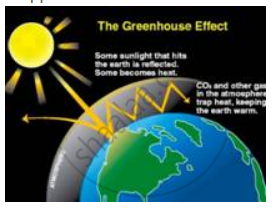Advertisements
Advertisements
Question
Our atmosphere acts as a greenhouse. Explain.
Solution
Our atmosphere contains greenhouse gases such as CO2, water vapour, O3, CH4, oxides of nitrogen and CFCs and allows the sun rays to come in. Sunlight reaching the Earth consists of three types of radiation-UV radiation, visible radiation, and IR radiation. As sunlight passes through the atmosphere, most UV radiation is absorbed by ozone; 30% of IR radiation reaches the Earth's surface, heating it up. As the Earth's surface becomes hot, it starts emitting radiation with less energy than the incoming radiation and thus with a longer wavelength. Some emitted IR radiation escapes from the Earth's surface and some is absorbed by CO2, thus remaining on the Earth. Trapped radiation warms the Earth's surface and lower layers of the atmosphere.

APPEARS IN
RELATED QUESTIONS
Explain the formation of acid rain due to:
Oxides of nitrogen
State the sources and effects of the following gas:
Water vapor
State the effects of greenhouse gases on the atmosphere.
Fill in the blank:
The ozone layer prevents the harmful ________ radiation of the sun to reach the earth.
Fill in the blank:
The decrease in the concentration of ozone in the stratosphere is the cause of the formation of __________ holes.
Select the correct answer:
A decrease in the amount of ozone in the stratosphere is called depletion of the zone and it is caused by
What is the effect of the following pollutants on living beings?
Lead
State what is meant by the term ‘atmospheric pollution’. Name four gaseous atmospheric pollutants.
Select the correct answer from the following statement:
The major pollutant released during burning of fossil fuels.
Acid rain has adverse effect on the environment State the effect acid rain has on the following:
The pH of water bodies.
